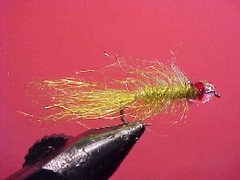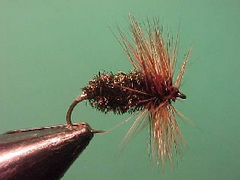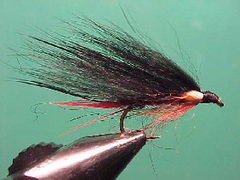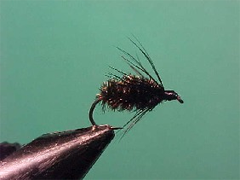Trout flies
{{start}}
{{end}}

{{+1}}BMS (Bullen Mary Special){{-1}}
{{start}}
At the 2003 Australian Fly Fishing Championships held at Mt. Beauty this was one of the few flies that produced more than one fish. It is a favorite fly at Lake Bullen Merri where it gets its name BM Special. Because of its history of success it is often regarded as a quintessential Rainbow trout fly by many Victorian fly fishers.{{end}}

{{+1}}Coch-Y-Bonddu{{-1}}
{{start}}
The Cock-Y-Bonddu is a Welsh beetle pattern which is equally at home on Australian trout waters. The original was tied with flat silver tinsel wound around the hook shank just behind the body. This little bit of flash isn't intended to represent a tail its more likely that it was included to imitate the beetle wing parts that often trail behind a beetle like a tail when it gets trapped in the water mid flight.{{end}}

{{+1}}Yeti variant{{-1}}
{{start}}
In its larger sizes, this fly fishes well and is equally at home fished as either a general prospecting fly retrieved slow and deep around weedy margins or as a fly for windy conditions where it can be allowed to slosh around for a few seconds and then can be slowly retrieved or as a point or attractor fly in a loch style fishing team of flies. In windier conditions it also works well when ripped across the surface.{{end}}

{{+1}}Booby – traditional booby{{-1}}
{{start}}
With the tow point at the tip of the 90 degree stem any forward movement of the fly raises the fly up a little and a steady forward movement of the fly creates a very natural wake. If just twitched it creates circles reminiscent of a struggling terrestrial insect.{{end}}

{{+1}}Red and orange spinner{{-1}}
{{start}}
The term 'spinner' refers to that stage in a Dun's life cycle when it has moved off the water or, vegetation etc. after drying its wings. The adult or imago of all Mayflies, Caddis flies and Midges can technically be regarded as spinners. The following Spinner is a generic representation for members of the “Leptophlebiidae” family of Mayflies and the various Highland Duns & Spinners, which are members of the “Oniscigastridae” family. Hatches generally occurs between the months of October and March. Carry black, brown, red and blue damsel versions.{{end}}

{{+1}}Irresistible{{-1}}
{{start}}
The Adams Irresistible is just one representation of a Baetis Dun. It floats like a cork and what's more fish accept it as a variety of food items. In smaller sizes it is an excellent Baetis Dun imitation and an excellent fly in still water particularly when Snow Flake Caddis are about. In larger sizes it is an excellent fly for fast water or as a top fly in dry / nymph combination. Change the material colours to tie flies representing Baetis Duns in your target fishery. I carry Adams, black, brown and olive versions in a couple of sizes.{{end}}

{{+1}}Lepto Dun{{-1}}
{{start}}
I use this fly to represent mayflies that are members of the Leptophlebiidae classification of mayflies which includes the Highland Dun and Olive Dun and also the Kosciuszko Dun which is a member of the Coloburiscidae classification of the Mayfly family.{{end}}

{{+1}}Black and peacock{{-1}}
{{start}}
Spider type flies like the Black and Peacock are very buggy and suggestive flies. Weather being used as a polaroiding fly, a static wet, one of the flies in a team of loch style flies, or a fly to cover rising fish spider type soft hackle flies may be taken as a snail, submerged beetle, drowned terrestrial, diving beetle or even a corixia. Alternatively the fish may just pick them up because of the movement of the soft hackle or the suggestive buggy nature of the overall shape.{{end}}

{{+1}}Black & peacock{{-1}}
{{start}}
Flies that represent spiders and beetles are very buggy and suggestive flies. Weather being used as a polaroiding fly, a static wet, one of the flies in a team of loch style flies, or a fly to cover rising fish spider type soft hackle flies may be taken as a snail, submerged beetle, drowned terrestrial, diving beetle or even a carixia.{{end}}

{{+1}}Red Tag{{-1}}
{{start}}
The red tag is as relevant today as when it was first invented some 140 years ago. It is perhaps the quintessential beetle imitation and is popular worldwide.{{end}}













